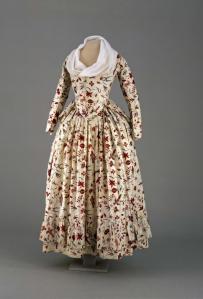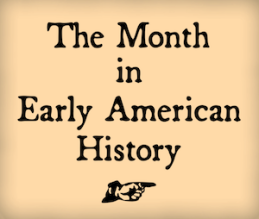Today’s #ColonialCouture post is by Jennifer Van Horn, assistant professor of art history and history at the University of Delaware. She specializes in the fields of early American art and material culture, and she is the author of The Power of Objects in Eighteenth-Century British America.

Figure 1. Woman’s Jacket and Petticoat worn by Ann Van Rensselaer, c. 1790. Albany, NY. Textile: India. Cotton chintz, mordant painted and dyed; tabby linen bodice and sleeve linings. The Colonial Williamsburg Foundation. Gift of Mrs. Cora Ginsburg.
Acc. No. 1990-10,1.
Walking down the street in Alexandria, Virginia, in 1786, a white woman spotted a gown that had been stolen from her two years before on the body of an enslaved woman. The gown was a fashionable one: an “Indian Chintz, white Ground, with Stripes and Figures of different Sorts of red, if not other Colours.” It might have resembled the chintz jacket and petticoat worn by Ann Van Rensselaer in New York about 1790 (fig 1), or the more delicately-patterned robe à l’anglaise donned by an unknown American woman around the same time (fig 2). Indian chintz—a light-weight cotton fabric painted or dyed with intricate organic designs and manufactured in India—was popular throughout the Atlantic world for clothing, bed hangings, and upholstery.[1]
The chintz gown’s original owner, Mrs. MacIver, was the wife of an Alexandria ferry owner. She claimed that a white seamstress, to whom she gave “a Night’s Quarters” after hearing “a Tale of feigned Distress,” stole the garment along with two other “elegant, well trimm’d Gowns.” The seamstress sold the Indian chintz to a “Negro of Dr Stewart’s,” who then “sold it to a Negroe Woman belonging to” George Washington. Mrs. MacIver discovered which enslaved woman—Charlotte—when she saw her strolling in Alexandria. Charlotte, then in her early to mid-twenties, was a seamstress for Martha Washington at Mount Vernon.[2] Continue reading →
 Dear Junto readers, Thank you for joining us for two weeks of all-new scholarship tracing the historical patterns of #ColonialCouture! Read the whole roundtable here.
Dear Junto readers, Thank you for joining us for two weeks of all-new scholarship tracing the historical patterns of #ColonialCouture! Read the whole roundtable here.



 Today’s #ColonialCouture post is by Amy Sopcak-Joseph, a doctoral candidate in American history at the University of Connecticut. She is working on her dissertation, “Fashioning American Women: Godey’s Lady’s Book, Female Consumers, and Periodical Publishing in the Nineteenth Century.” Follow her @AmySopcakJoseph.
Today’s #ColonialCouture post is by Amy Sopcak-Joseph, a doctoral candidate in American history at the University of Connecticut. She is working on her dissertation, “Fashioning American Women: Godey’s Lady’s Book, Female Consumers, and Periodical Publishing in the Nineteenth Century.” Follow her @AmySopcakJoseph.


 Rise and shine, it’s time to relaunch our regular(ish) roundup of breaking news from early America. To the links!
Rise and shine, it’s time to relaunch our regular(ish) roundup of breaking news from early America. To the links!